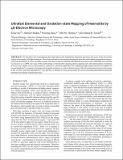Ultrafast elemental and oxidation-state mapping of hematite by 4D electron microscopy
Abstract
We describe a new methodology that sheds light on the fundamental electronic processes that occur at the subsurface regions of inorganic solid photocatalysts. Three distinct kinds of microscopic imaging are used that yield spatial, temporal and energy-resolved information. We also carefully consider the effect of photon-induced near-field electron microscopy (PINEM), first reported by Zewail et al. in 2009. The value of this methodology is illustrated by studying afresh a popular and viable photocatalyst, hematite, α-Fe2O3, that exhibits most of the properties required in a practical application. By employing high-energy electron-loss signals (of several hundred eV), coupled to femtosecond temporal resolution as well as ultrafast energy-filtered transmission electron microscopy in 4D, we have, inter alia, identified Fe4+ ions that have a lifetime of a few picoseconds, as well as associated photoinduced electronic transitions and charge transfer processes.
Citation
Su , Z , Baskin , J S , Zhou , W , Thomas , J & Zewail , A 2017 , ' Ultrafast elemental and oxidation-state mapping of hematite by 4D electron microscopy ' , Journal of the American Chemical Society , vol. 139 , no. 13 , pp. 4916-4922 . https://doi.org/10.1021/jacs.7b00906
Publication
Journal of the American Chemical Society
Status
Peer reviewed
ISSN
0002-7863Type
Journal article
Description
This work was supported by the Air Force Office of Scientific Research (FA9550-11-1-0055) in the Gordon and Betty Moore Center for Physical Biology at the California Institute of Technology.Collections
Items in the St Andrews Research Repository are protected by copyright, with all rights reserved, unless otherwise indicated.

